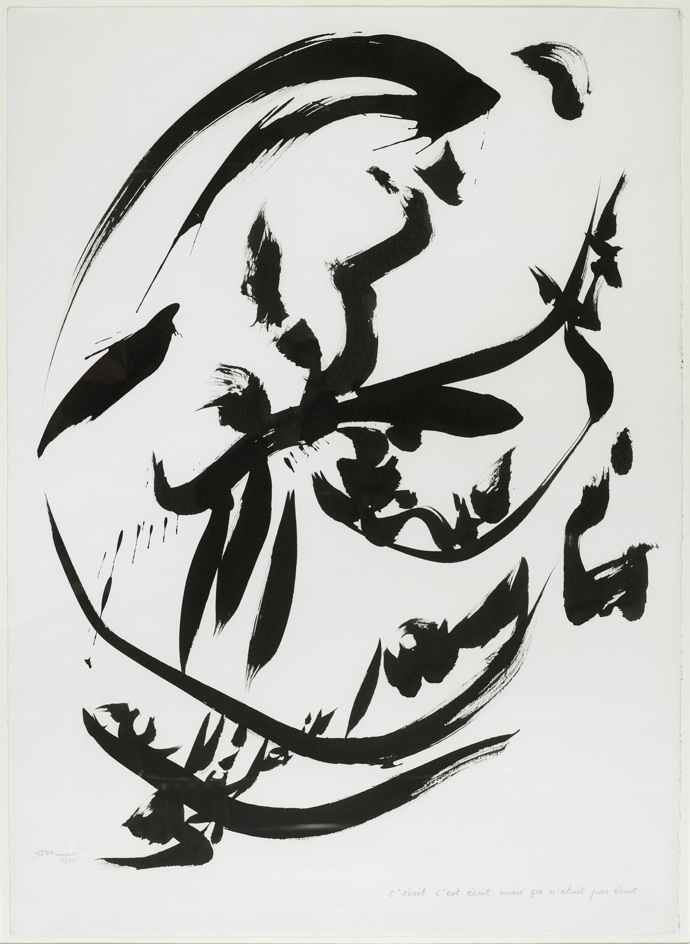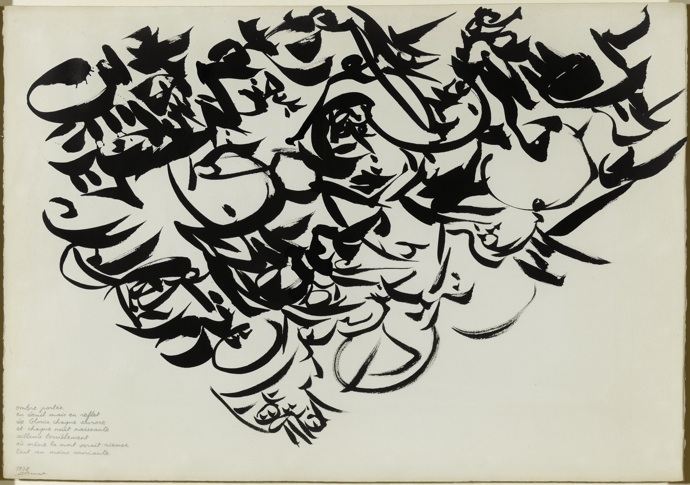from pastelegram.org, June 2011 – April 2014
Christian Dotremont: Logogrammes
In 1975 Christian Dotremont performed a familiar action; ink brush in hand, he traced an idea. The resulting image, fetal in form, bears little resemblance to writing until one reads the small, faint line written in graphite below: c'écrit c'est écrit mais ça n'était pas écrit. This writing is written but it is not written. And so, the sweeping broken arc above this cursive clue becomes a C. The discrete and accidental marking in the upper right hand corner now joins the C as an apostrophe representing some omitted character. Upon discovering this key, one searches the boldly inked calligraphy for intelligible Roman lettering in expectation that it will correspond to the pencil script below. But in Dotremont’s game shifting one’s attention from graphite key to inked enigma proves futile. This is why c'écrit c'est écrit mais ça n'était pas écrit—“this writing is written but it is not written”—a witticism fast approaching cliché, is emblematic of Dotremont’s logogrammatic practice and crucial to any understanding of his system.

Tucked away on the fourth floor of the Centre Pompidou, Logogrammes features over seventy graphic works by the Belgian-born artist Christian Dotremont from the years 1960 to 1978. A founding member of CoBrA, Dotremont explored abstract modes of expression since the late 1940s, but his interest in the visual aspect of language solidified in 1950 when he wrote a text entitled “Signification et sinification” for CoBrA’s journal. In this text Dotrement compares Chinese ideographs with the visual language of artists, claiming to understand Chinese writing as he does “a page of writing by Miró, a word by Arp, a sentence by Hartung, a slate by Ubac.”1 For Dotremont, the French text emerges as that which is encrypted and undecipherable: “in short the system code was reversed.”2
Though arranged chronologically, the works in Logogrammes do not display a discernible stylistic evolution. For a brief moment in 1965, Dotremont preferred pastel to black India ink, but generally he created his dessin-mots with minimal means, using an inkbrush, ink, and paper scrolls of various sizes. Despite the material ritual of his process and the initial visual uniformity of black writing on white paper, Dotremont’s markings are surprisingly diverse. While his word drawings often resemble Arabic or Japanese calligraphy, he vacillates between the two and invents dynamic hybrids along the way.3 In en hiver un jour lapon donc de nuit … of 1971, his sweeping serifs and stippled punctuations create a fluid and regular rhythm. In Logstory of 1974, a narrative spanning several pages, his clumped and tangled scribbles jump from sheet to sheet. In Or les choses du paysage lapon hivernal sont à la fois rares et nombreuses… of 1975 his scrawl creates avian flurries that tear across the page.
Dotremont’s writings, which range from fanciful stories to playful dialogues to pithy maxims, are almost always transliterated into legible text for his readers. And yet sometimes unnecessarily so. In parfois, ne fais qu’attendre: c’est vivre le temps même (“sometimes don’t wait: time itself is for living”) of 1971, for instance, one can—just barely—make out the majority of the Roman letters. Though one could conceivably unravel this message through careful study, even this work displays the titles written in graphite as key and the inked calligraphy as enigma. Thus it’s not clear why Dotremont relies on this double writing.

We may find some clarification in one of the few works in the exhibition that does not bear a graphite title. In Je suis un logogramme né à Tervuren ou plutôt je nais de cat instant ("I am a logogram born in Tervuren or rather I am born in this moment") of 1969, Dotremont, born in Tervuren in 1922, portrays himself as a logogram constantly reborn in the act of transcription. This self-referential work perhaps needed no transliteration, for Dotremont composed this word poem as a personal credo rather than a work to be misunderstood or decoded. As he wrote in 1950, “If there were no misunderstandings between you the reader and me the writer, I probably would not write; our misunderstandings unite us ... [without them] everything would be pleonasm.”4 Writing in graphite, Dotremont complicates the reception of his word drawings and creates a space for misunderstanding. In Dotremont’s code, the logogram is a form of direct expression while the cursive writing explicating the logogram is that which conceals meaning. Our key is his enigma.
In 1975, when Dotremont writes twice, “This writing is written but it is not written,” the pencil script does not describe the dessin-mots above it, but each form informs the other. At the very same time that deconstructionists were addressing the concept of “the written,” Dotremont was exploring—through gesture and variation—the significance of writing. Logogrammes presents a visually stimulating and conceptually rich body of work, exciting in its ostensible redundancy.
- 1. Christian Dotremont, “Signification et sinification.” Cobra. Revue Internationale de l’art expérimental, n°7, Bruxelles, automne 1950, p. 19-20.
- 2. Ibid.
- 3. In 1958 Dotremont and Pierre Alechinsky collaborated on a sixteen-minute documentary, Calligraphie japonaise, for which Dotremont provided commentary.
- 4. Christian Dotremont, “Signification et sinification.” Cobra. Revue Internationale de l’art expérimental, n°7, Bruxelles, automne 1950, p. 19-20.